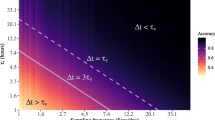Summary
A recent paper in this journal has analysed world records in three types of locomotion, making extensive use of mathematical and statistical techniques. There are a number of methodological flaws in much of the authors' use of these techniques. Some of these are fundamental and others are less serious. This paper draws the attention of readers of this journal to these flaws, with comment and suggestions. This is done in the hope that researchers using mathematical and statistical techniques will be made more aware of limitations to their methodology.
Similar content being viewed by others
References
Altman DG (1980) Statistics and ethics in medical research. Misuse of statistics is unethical. Br Med J 281: 1182–1184
Altman DG (1981) Statistics and ethics in medical research. VIII — Improving the quality of statistics in medical journals. Br Med J 282: 44–47
Altman DG (1982) Statistics in medical journals. Stat Med 1: 59–71
Burghes DN (1979) World records in athletics. J Math Modelling Teachers 2: 54–56
Furlong JDG, Szreter R (1975) The trend of the performance differential between leading men and women athletes, 1951–1967. Statistician 24: 115–125
Freund H, Zouloumian P (1981) Lactate after exercise in man: I. Evolution kinetics in arterial blood. Eur J Appl Physiol 46: 121–133
Gore SM, Jones IG, Rytter EC (1977) Misuse of statistical methods: Critical assessment of articles in BMJ from January to March 1976. Br Med J 278: 85–87
Mead R, Pike DJ (1975) A review of response surface methodology from a biometric viewpoint. Biometrics 31: 803–851
Mognoni P, Lafortuna C et al. (1982) An analysis of world records in three types of locomotion. Eur J Appl Physiol 49: 287–299
Morton RH (1983) The supreme runner: What evidence now? Aust J Sports Sci 3: 7–10
O'Fallon JR, Duby SB et al. (1978) Should there be statistical guidelines for medical research papers? Biometrics 34: 687–695
Purdy JG (1974) Least squares model for the running curve. Res Q 45: 224–238
Reigel PS (1977) Time predicting. Runners World Magazine: 12 (8)
Reigel PS (1981) Athletic records and human endurance. Am Scientist 69: 285–290
Rumball WM, Coleman CE (1970) Analysis of running and the prediction of ultimate performance. Nature 228: 184–185
Ryder HW, Carr HJ, Herget P (1976) Future performance in foot-racing. Sci Am 234: 108–119
Schor S (1967) Statistical reviewing program for medical manuscripts. Am Statistic 21: 28–31
Schor S, Karten I (1966) Statistical evaluation of medical journal manuscripts. J Am Med Assoc 195: 1123–1128
Story P, Payne H (1969) A comparison of women's performances with men's in sport. Phys Educ 61: 184
Zouloumian P, Freund H (1981a) Lactate after exercise in man: II. Mathematical model. Eur J Appl Physiol 46: 135–147
Zouloumian P, Freund H (1981b) Lactate after exercise in man: III. Properties of the compartment model. Eur J Appl Physiol 46: 149–160
Author information
Authors and Affiliations
Rights and permissions
About this article
Cite this article
Morton, R.H., Mognoni, P. Comment on “An analysis of world records in three types of locomotion”. Europ. J. Appl. Physiol. 52, 324–327 (1984). https://doi.org/10.1007/BF01015219
Accepted:
Issue Date:
DOI: https://doi.org/10.1007/BF01015219




